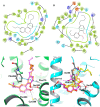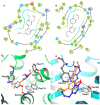In Vitro and In Silico Studies of Neolignans from Magnolia grandiflora L. Seeds against Human Cannabinoids and Opioid Receptors
- PMID: 36770918
- PMCID: PMC9920749
- DOI: 10.3390/molecules28031253
In Vitro and In Silico Studies of Neolignans from Magnolia grandiflora L. Seeds against Human Cannabinoids and Opioid Receptors
Abstract
Magnolia grandiflora L. (Magnoliaceae) is a plant of considerable medicinal significance; its flowers and seeds have been used in various traditional remedies. Radioligand binding assays of n-hexane seeds extract showed displacement of radioligand for cannabinoid (CB1 and CB2) and opioid δ (delta), κ (kappa), and µ (mu) receptors. Bioactivity-guided fractionation afforded 4-O-methylhonokiol (1), magnolol (2), and honokiol (3), which showed higher binding to cannabinoid rather than opioid receptors in radioligand binding assays. Compounds 1-3, together with the dihydro analog of 2 (4), displayed selective affinity towards CB2R (Ki values of 0.29, 1.4, 1.94, and 0.99 μM, respectively), compared to CB1R (Ki 3.85, 17.82, 14.55, and 19.08 μM, respectively). An equal mixture of 2 and 3 (1:1 ratio) showed additive displacement activity towards the tested receptors compared to either 2 or 3 alone, which in turn provides an explanation for the strong displacement activity of the n-hexane extract. Due to the unavailability of an NMR or X-ray crystal structure of bound neolignans with the CB1 and CB2 receptors, a docking study was performed to predict ligand-protein interactions at a molecular level and to delineate structure-activity relationships (SAR) of the neolignan analogs with the CB1 and CB2 receptors. The putative binding modes of neolignans 1-3 and previously reported related analogs (4, 4a, 5, 5a, 6, 6a, and 6b) into the active site of the CB1 and CB2 receptors were assessed for the first time via molecular docking and binding free-energy (∆G) calculations. The docking and ∆G results revealed the importance of a hydroxyl moiety in the molecules that forms strong H-bonding with Ser383 and Ser285 within CB1R and CB2R, respectively. The impact of a shift from a hydroxyl to the methoxy group on experimental binding affinity to CB1R versus CB2R was explained through ∆G data and the orientation of the alkyl chain within the CB1R. This comprehensive SAR, influenced by the computational study and the observed in vitro displacement binding affinities, has indicated the potential of magnolia neolignans for developing new CB agonists for potential use as analgesics, anti-inflammatory agents, or anxiolytics.
Keywords: 4-O-methylhonokiol; Magnolia grandiflora; cannabinoid; honokiol; magnolol; molecular docking; opioid; tetrahydromagnolol.
Conflict of interest statement
The authors declare no conflict of interest.
Figures








Similar articles
-
7-Azaindolequinuclidinones (7-AIQD): A novel class of cannabinoid 1 (CB1) and cannabinoid 2 (CB2) receptor ligands.Bioorg Med Chem Lett. 2020 Nov 15;30(22):127501. doi: 10.1016/j.bmcl.2020.127501. Epub 2020 Aug 31. Bioorg Med Chem Lett. 2020. PMID: 32882418 Free PMC article.
-
A new dimeric neolignan from Magnolia grandiflora L. seeds.Arch Pharm Res. 2015 Jun;38(6):1066-71. doi: 10.1007/s12272-014-0476-4. Epub 2014 Sep 6. Arch Pharm Res. 2015. PMID: 25193624
-
In vitro opioid receptor affinity and in vivo behavioral studies of Nelumbo nucifera flower.J Ethnopharmacol. 2015 Nov 4;174:57-65. doi: 10.1016/j.jep.2015.08.006. Epub 2015 Aug 7. J Ethnopharmacol. 2015. PMID: 26260436 Free PMC article.
-
Cannabinoid CB1 and CB2 receptor ligand specificity and the development of CB2-selective agonists.Curr Med Chem. 2008;15(14):1428-43. doi: 10.2174/092986708784567716. Curr Med Chem. 2008. PMID: 18537620 Review.
-
Cannabinoids in pain management: CB1, CB2 and non-classic receptor ligands.Expert Opin Investig Drugs. 2014 Aug;23(8):1123-40. doi: 10.1517/13543784.2014.918603. Epub 2014 May 16. Expert Opin Investig Drugs. 2014. PMID: 24836296 Review.
Cited by
-
Extraction and Biological Activity of Lignanoids from Magnolia officinalis Rehder & E.H.Wilson Residual Waste Biomass Using Deep Eutectic Solvents.Molecules. 2024 May 16;29(10):2352. doi: 10.3390/molecules29102352. Molecules. 2024. PMID: 38792212 Free PMC article.
-
Cannabinoid Receptor Type II Ligands from Sandalwood Oil and Synthetic α-Santalol Derivatives.J Nat Prod. 2023 Jul 28;86(7):1786-1792. doi: 10.1021/acs.jnatprod.3c00282. Epub 2023 Jul 14. J Nat Prod. 2023. PMID: 37450763 Free PMC article.
References
-
- Pandey P., Roy K.K., Liu H., Ma G., Pettaway S., Alsharif W.F., Gadepalli R.S., Rimoldi J.M., McCurdy C.R., Cutler S.J., et al. Structure-based identification of potent natural product chemotypes as cannabinoid receptor 1 inverse agonists. Molecules. 2018;23:2630. doi: 10.3390/molecules23102630. - DOI - PMC - PubMed
MeSH terms
Substances
LinkOut - more resources
Full Text Sources
Research Materials
Miscellaneous

